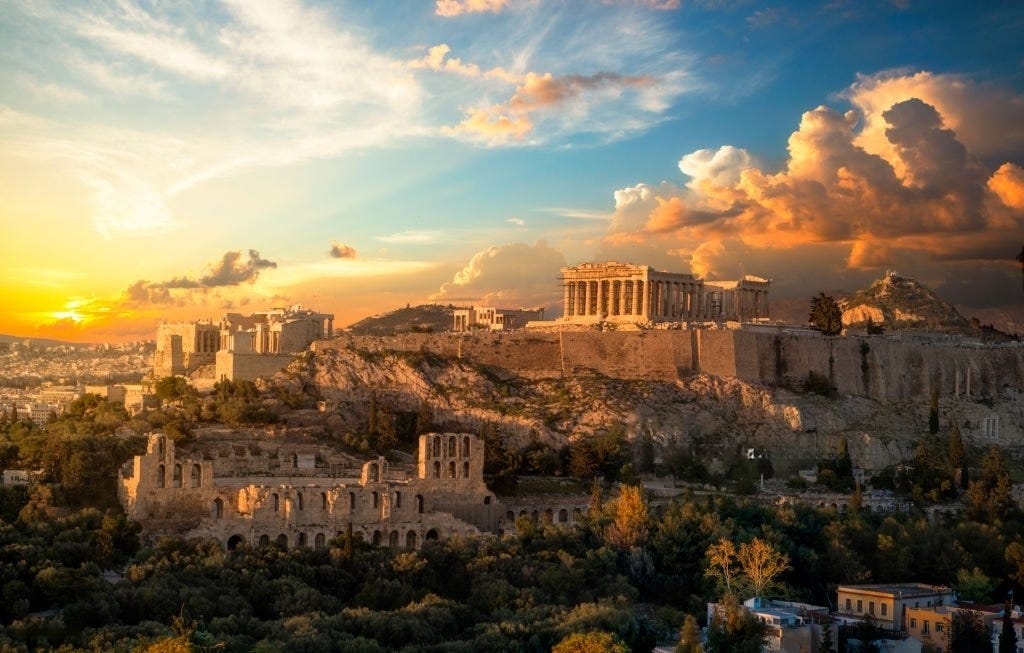Uncover the treasures of ancient Athens: Discover the birthplace of democracy.
Athens, the capital city of Greece, is not only known for its vibrant culture and stunning architecture but also for its rich historical significance. As the birthplace of democracy, Athens holds a plethora of historical gems that attract visitors from all over the world. From ancient ruins to iconic landmarks, exploring the historical gems of Athens offers a unique opportunity to delve into the roots of Western civilization and witness the remnants of a glorious past. Join us on a journey through time as we uncover the fascinating historical treasures that make Athens a must-visit destination for history enthusiasts.
The Acropolis: A Symbol of Ancient Greek Power and Culture
The Acropolis: A Symbol of Ancient Greek Power and Culture
Athens, the capital city of Greece, is a treasure trove of historical gems that offer a glimpse into the birthplace of democracy. One such gem is the Acropolis, a hilltop citadel that stands as a symbol of ancient Greek power and culture. Perched high above the city, the Acropolis is a testament to the architectural brilliance and artistic mastery of the ancient Greeks.
The Acropolis, meaning “high city” in Greek, is home to several iconic structures, the most famous of which is the Parthenon. Built in the 5th century BC, the Parthenon is a temple dedicated to the goddess Athena, the patron deity of Athens. Its grandeur and architectural precision make it a marvel of ancient engineering. The temple’s columns, meticulously carved with intricate details, stand tall and proud, reflecting the power and influence of the ancient Greeks.
As one ascends the hill to reach the Acropolis, the Propylaea, the monumental gateway to the sacred site, greets visitors. Its imposing structure, adorned with elegant Doric columns, sets the stage for the awe-inspiring sights that lie beyond. Walking through the Propylaea, one is transported back in time, surrounded by the remnants of a civilization that laid the foundation for modern democracy.
Beyond the gateway, the Erechtheion, another iconic structure, comes into view. This temple, dedicated to both Athena and Poseidon, showcases the mastery of ancient Greek architecture. Its most notable feature is the Porch of the Caryatids, where six female statues serve as columns, supporting the roof with their graceful poses. These statues, replicas of the originals now housed in the Acropolis Museum, are a testament to the artistic prowess of the ancient Greeks.
The Acropolis is not just a collection of magnificent structures; it is also a repository of ancient Greek art. The Acropolis Museum, located at the foot of the hill, houses a vast collection of artifacts that provide insight into the daily lives and beliefs of the ancient Greeks. From intricately carved marble statues to delicate pottery, the museum offers a comprehensive view of the artistic achievements of this ancient civilization.
Visiting the Acropolis is a journey through time, allowing visitors to immerse themselves in the rich history and culture of ancient Greece. As one gazes out from the hilltop, the panoramic view of Athens unfolds, revealing a city that has evolved over centuries, yet still bears the marks of its ancient past. The Acropolis stands as a reminder of the enduring legacy of the ancient Greeks and their contributions to the world.
In conclusion, the Acropolis is a symbol of ancient Greek power and culture. Its grand structures, such as the Parthenon and the Erechtheion, showcase the architectural brilliance of the ancient Greeks. The Acropolis Museum, with its vast collection of artifacts, provides a deeper understanding of the artistic achievements of this ancient civilization. Visiting the Acropolis is a journey back in time, allowing visitors to appreciate the rich history and cultural heritage of Athens, the birthplace of democracy. As one explores this historical gem, it becomes evident that the Acropolis is not just a collection of ancient ruins; it is a testament to the enduring legacy of the ancient Greeks and their contributions to the world.
The Agora: Uncovering the Heart of Ancient Athenian Life
The Agora: Uncovering the Heart of Ancient Athenian Life
In the bustling city of Athens, amidst the remnants of a glorious past, lies a historical gem that offers a glimpse into the birthplace of democracy. The Agora, a central gathering place in ancient Athens, was the heart of Athenian life and a hub of political, social, and commercial activities. Today, it stands as a testament to the rich history and cultural significance of this ancient city.
The Agora, located at the foot of the Acropolis, was a sprawling marketplace that served as the center of civic life in ancient Athens. It was a place where citizens gathered to engage in political discussions, participate in democratic processes, and exchange goods and ideas. The word “agora” itself means “gathering place” in Greek, and it truly lived up to its name.
As one steps into the Agora, they are transported back in time to a bustling marketplace filled with merchants, artisans, and politicians. The ruins of ancient buildings, such as the Stoa of Attalos and the Temple of Hephaestus, stand as silent witnesses to the vibrant activities that once took place here. These structures, with their intricate architectural details, offer a glimpse into the grandeur of ancient Athenian civilization.
Walking through the Agora, one can imagine the lively debates that took place in the Bouleuterion, the meeting place of the Athenian Council. It was here that important decisions were made, laws were enacted, and the foundations of democracy were laid. The Bouleuterion, with its circular shape and tiered seating, provided an ideal setting for democratic discussions and deliberations.
Adjacent to the Bouleuterion is the Tholos, a circular building that served as the headquarters of the Prytaneis, the executive committee of the Athenian government. This building, with its distinctive architecture and intricate marble columns, was a symbol of political power and authority. It was here that the sacred fire, which represented the unity and continuity of the city-state, was kept burning.
Beyond the political and administrative buildings, the Agora was also a place of social and cultural significance. The Stoa of Attalos, a reconstructed colonnade, housed numerous shops and workshops where artisans and merchants sold their wares. It was a bustling center of commerce, where one could find a wide array of goods, ranging from pottery and jewelry to food and clothing.
The Agora was not just a place for business and politics; it was also a center for intellectual and philosophical pursuits. The Stoa of Zeus Eleutherios, a covered walkway adorned with statues and inscriptions, was a gathering place for philosophers and scholars. It was here that Socrates, Plato, and Aristotle engaged in philosophical debates and discussions, shaping the course of Western thought.
As one explores the Agora, they cannot help but be captivated by the rich history and cultural significance of this ancient site. It is a place where the foundations of democracy were laid, where ideas were exchanged, and where the vibrant spirit of ancient Athens comes alive. The Agora stands as a testament to the enduring legacy of this great city and serves as a reminder of the importance of civic engagement and democratic values.
In conclusion, the Agora is a historical gem that offers a fascinating glimpse into the birthplace of democracy. It was the heart of ancient Athenian life, a place where citizens gathered to engage in political discussions, participate in democratic processes, and exchange goods and ideas. Today, it stands as a testament to the rich history and cultural significance of Athens, a city that continues to inspire and captivate visitors from around the world.
The Parthenon: A Testament to Architectural Brilliance and Cultural Significance
The Parthenon, a magnificent temple perched atop the Acropolis in Athens, stands as a testament to architectural brilliance and cultural significance. Built in the 5th century BCE, this iconic structure is a symbol of the golden age of Athens and the birthplace of democracy. Its grandeur and meticulous design continue to captivate visitors from around the world.
The Parthenon was constructed under the supervision of the renowned architect Phidias, who spared no expense in creating a masterpiece that would honor the goddess Athena. The temple was built using the finest materials available at the time, including Pentelic marble, which gives the structure its ethereal glow. The sheer size and scale of the Parthenon are awe-inspiring, with its dimensions measuring 69.5 meters long, 30.9 meters wide, and 13.5 meters tall.
The architectural brilliance of the Parthenon lies in its perfect proportions and meticulous design. The temple follows the Doric order, characterized by its sturdy columns and simple, yet elegant, design. The columns, which surround the temple on all sides, create a sense of harmony and balance. Each column is intricately carved with flutes, adding a touch of sophistication to the overall structure. The attention to detail is evident in every aspect of the Parthenon, from the precise alignment of the columns to the intricate friezes that adorn the pediments.
The cultural significance of the Parthenon cannot be overstated. Dedicated to Athena, the patron goddess of Athens, the temple served as a symbol of the city’s power and prosperity. It housed a colossal statue of Athena, crafted by Phidias himself, which was considered one of the Seven Wonders of the Ancient World. The statue, made of gold and ivory, depicted the goddess in all her glory, holding a shield and a spear. Unfortunately, the statue was lost to history, but its grandeur and significance are still felt within the walls of the Parthenon.
Over the centuries, the Parthenon has witnessed numerous transformations and suffered the ravages of time. It was converted into a Christian church in the 6th century CE and later transformed into a mosque during the Ottoman Empire. In the 17th century, a devastating explosion caused significant damage to the temple, leaving it in ruins. However, efforts to restore and preserve the Parthenon have been ongoing since the 19th century, ensuring that its architectural brilliance and cultural significance endure.
Today, the Parthenon stands as a UNESCO World Heritage Site and a symbol of ancient Greece’s cultural legacy. Visitors from around the world flock to Athens to marvel at its grandeur and immerse themselves in its rich history. The temple’s commanding presence atop the Acropolis offers breathtaking views of the city, serving as a reminder of Athens’ glorious past.
In conclusion, the Parthenon is a testament to architectural brilliance and cultural significance. Its grandeur and meticulous design continue to captivate visitors, while its cultural legacy as the birthplace of democracy and symbol of ancient Greece’s power and prosperity remains intact. As one explores the historical gems of Athens, the Parthenon stands as a shining example of the city’s rich heritage and enduring legacy.In conclusion, Athens is a city rich in historical gems that offer a glimpse into the birthplace of democracy. From iconic landmarks such as the Acropolis and the Parthenon to the ancient Agora and the Temple of Hephaestus, Athens is a treasure trove of historical sites. Exploring these sites allows visitors to immerse themselves in the rich history and culture of ancient Greece, and gain a deeper understanding of the foundations of democracy. Athens truly stands as a testament to the enduring legacy of its historical gems.


